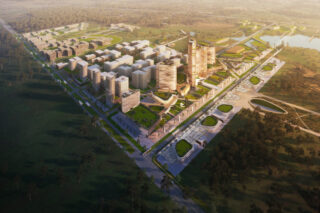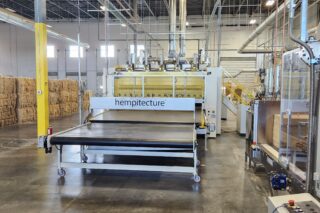How can design and technology resolve environmental issues to create a better future?
This question has been repeated throughout the years and, for the Design in the Age of Experience exhibition which took place during the Milan Design Week 2018, Dassault Systèmes invited artists, architects and innovators to come together and showcase concrete solutions. The internationally renowned architectural firm Kengo Kuma and Associates presented the sustainable design installation Breath / ng.
The firm used the Dassault Systèmes’ 3DEXPERIENCE platform which pushes materials to their limits by relying on a virtual environment to design and test them upstream. With this technology, Kengo Kuma and his team were able to manipulate the geometry of a special fabric which absorbs CO² in order to address the global problem of increasing air pollution. The installation in Milan is said to have the capability of absorbing pollution from 90,000 cars.
Kuma’s convinced that the combination of design and technology can provide a significant response to the environmental problems of the modern world. He’s not alone. Artists Daan Roosegaarde—with his smog-free tower—and Wesley Goatley—with his data-based light installation—added essential features to the exhibition. Watch our video report below to learn more about solutions for pollution in urban settings.
Inspired, Dassault Systèmes organized an entire event around Kengo Kuma’s central concept. Attendees had the opportunity to listen to speakers such as Kengo Kuma and Dutch artist and innovator Daan Roosegaarde talk about urban mobility.
As one of the designers behind the Project i, resulting in the BMW i3, and Head of Group Design Sustainability Strategy for BMW Group, Daniela Bohlinger explained how BMW is working on the new i3 in collaboration with the Ocean Conservatory in order to implement new recycled plastic into the company’s future car designs.

The BMW i3 with sea plastic granulate. Courtesy of BMW.
“Economical, ecology and social, you have to tackle this three together. If you want to work circle: save weight, use purpose-driven design, use recycled materials, approaching the industry by demanding it.”
On the same theme, MIT Senseable City Lab director Carlo Ratti discussed a series of projects including his ANAS smart road system, groups of drones that monitor traffic and also act as a safety and maintenance assistance for tunnels and viaducts.
“Intelligent mobility can help avoid car accidents since every vehicle is aware of where all the other ones are located.”
You might like to read “Carlo Ratti Associati Designs First Smart Highway System in Italy”.
Ratti also spoke of the autonomous self-driving boats they developed in Amsterdam call Roboats.
“Roboats act as transportation to move stuff around and as temporary bridges.”
He spoke of Paint by Drone systems—controlled flying drones can cover buildings with giant paintings—which he also proposed to use as a personal tour guide for visitors to the MIT campus. The drones can be on huge campuses acting as guidance and information points for first-time university students who tend to get lost easily.
“The idea is to develop the panoramic vision for the passenger.”

Carlo Ratti unveils the smart road system in Italy. “Carlo Ratti Associati Designs First Smart Highway System in Italy”
Here’s to combining technology and the design world. Only good things to come.










